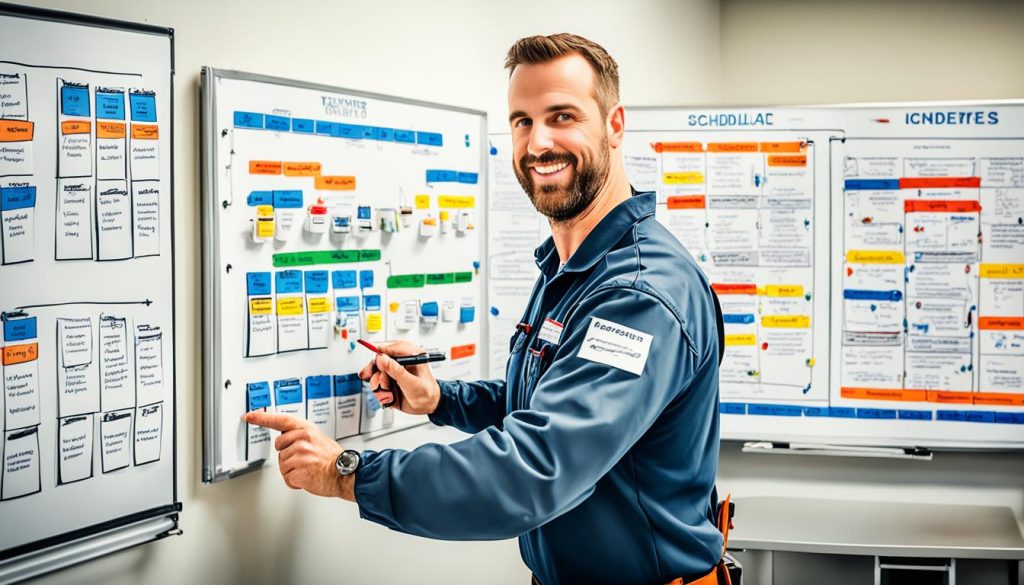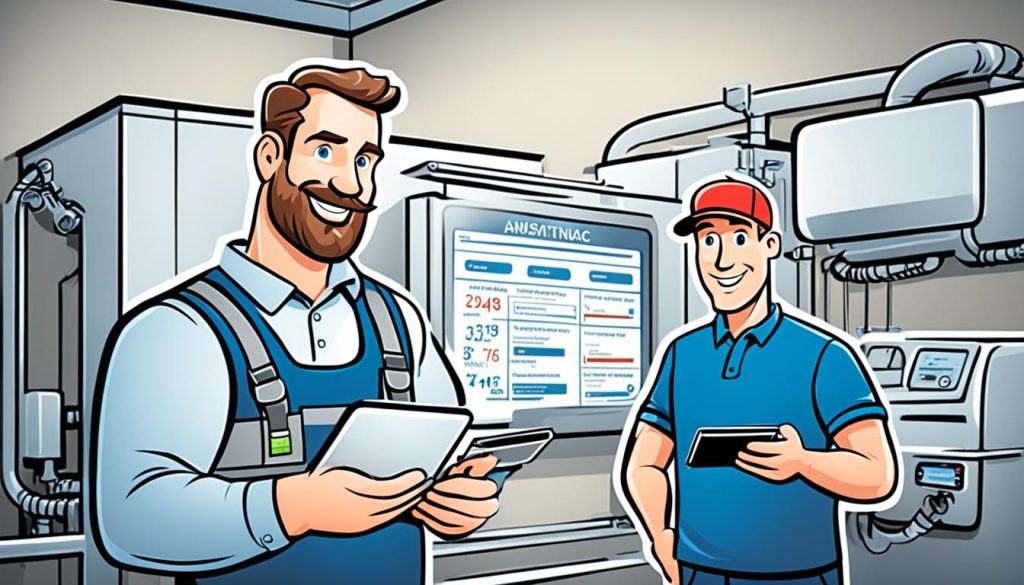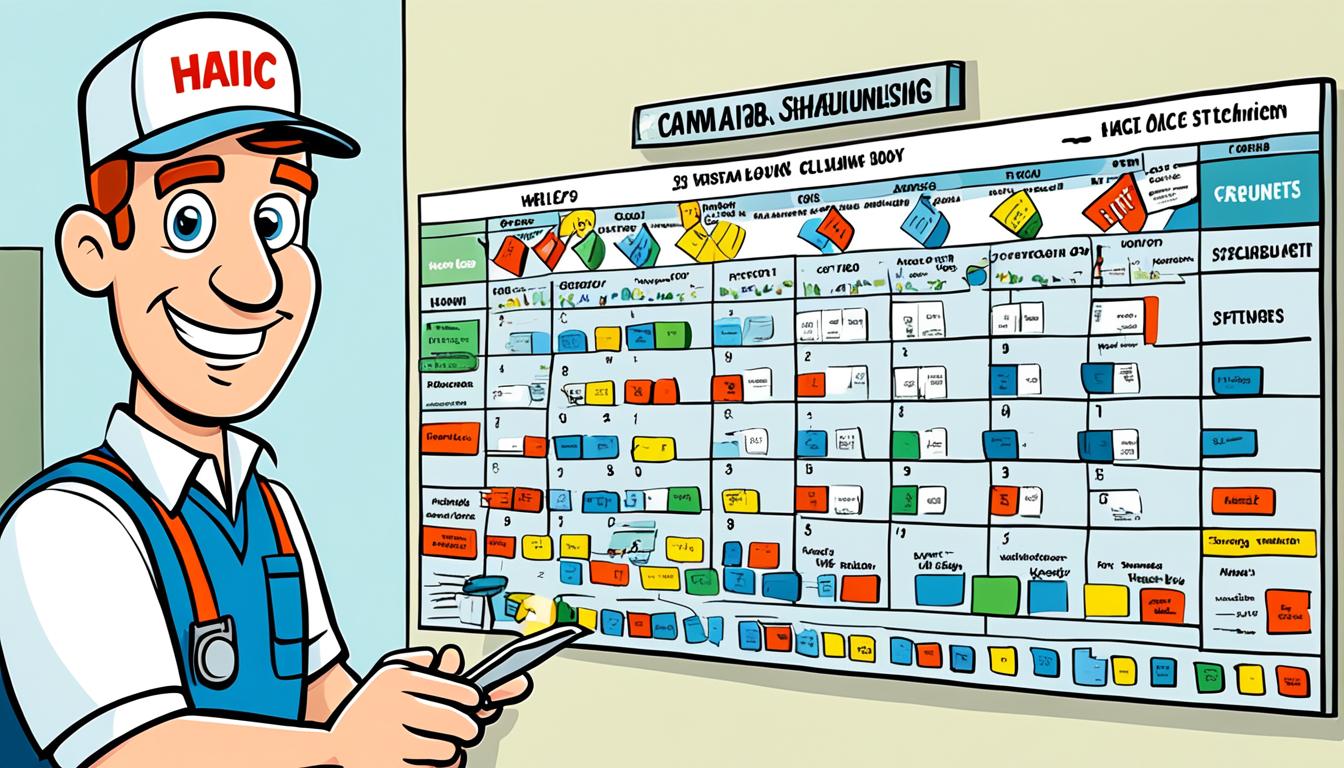To make HVAC technician scheduling more efficient, use smart workforce management and special software. This helps increase productivity, reduce costs, and make customers happier with your service.
Start by checking how your current scheduling works. Look for any problems or areas that could be better. Then, make plans to fix these issues. Using software for scheduling your HVAC technicians is crucial. It helps automate tasks like assigning jobs, planning routes, and keeping everyone updated in real-time.
For the best results, make decisions based on data and always check how you’re doing. This way, you can keep improving your scheduling. It helps your HVAC business stay ahead and meet customer needs well.
Understanding the Importance of Efficient HVAC Technician Scheduling
Efficient HVAC field service scheduling is key for a successful HVAC business. It impacts customer satisfaction, reduces costs, and boosts technician productivity. Let’s see why it’s so important.
Impact on Customer Satisfaction
Streamlining HVAC technician scheduling boosts customer satisfaction. Shorter wait times and quick service make customers happy. By managing your team well, you can answer service calls fast and meet what customers expect.
Cost Reduction Benefits
Good HVAC field service scheduling cuts costs. You can plan routes to use less fuel and cut down on travel time. This means lower expenses and more profit for your HVAC business.
Improved Technician Productivity
Smart scheduling makes technicians more productive. By balancing their work and reducing travel, they can finish more jobs in a day. This leads to more completed jobs and better performance.
| Scheduling Aspect | Impact on Business |
|---|---|
| Customer Satisfaction | Increased loyalty and referrals |
| Cost Reduction | Higher profit margins |
| Technician Productivity | More completed jobs per day |
Putting a focus on efficient HVAC technician scheduling helps your business succeed. You’ll see better customer relationships, cost control, and more productivity. This leads to a stronger, more competitive HVAC operation.
Assessing Your Current Scheduling Processes
To make your HVAC field service better, start by checking how you schedule now. This step is key to finding better ways to plan routes for your HVAC technicians.
First, talk to your technicians and customers. What they say can show where things slow down, like in communication or planning. This helps you see where you can get better at optimizing your field service.
Then, use GPS tracking to see where your technicians go and how long it takes. Look at this data to find ways to make things faster, like routes that take too long. This helps you make smart choices for planning your technicians’ routes.
| Assessment Area | Data Source | Potential Insights |
|---|---|---|
| Communication | Technician and Customer Feedback | Delays in job assignments, miscommunication issues |
| Task Assignment | Scheduling Software Data | Uneven workload distribution, skill mismatches |
| Route Efficiency | GPS Tracking Data | Excessive travel time, inefficient job sequencing |
| Response Times | Service Call Logs | Delayed responses to urgent calls, customer wait times |
Looking closely at these areas will give you a full picture of your scheduling. This will help you make your field service better and more efficient.
Leveraging Technology for HVAC Dispatch Management
HVAC dispatch software changes how service companies manage their teams and tasks. It brings in digital tools to make operations smoother and more efficient.
HVAC Scheduling Software Options
There are many HVAC service scheduling software options for different business sizes and needs. ServiceTitan, FieldEdge, and Jobber are popular choices. They offer tools for scheduling, dispatching, and tracking technicians.
Key Features in Dispatch Software
When picking HVAC dispatch software, look for these key features:
- Real-time GPS tracking
- Automated scheduling
- Mobile app for technicians
- Customer communication tools
- Reporting and analytics
These features help make routes more efficient, cut down on wait times, and enhance service quality.
Integration with Existing Systems
It’s important for the software to work well with your current systems. Make sure it connects with your:
- Customer relationship management (CRM) system
- Accounting software
- Inventory management tools
This integration makes your workflow smoother, gets rid of data gaps, and boosts accuracy in your business.
Implementing Data-Driven Decision Making
Using data to make decisions is key in managing HVAC workforces. By looking at past data, you can spot trends in service calls and how technicians perform. This helps you improve your HVAC field service and make smart choices about how to use your resources.
First, find important performance indicators (KPIs) that show how well your scheduling works. These could be things like how fast you respond, how quickly jobs get done, and how happy customers are. Keep an eye on these numbers to see how you’re doing and where you can get better.
Use data tools to understand where technicians should go and how to plan their routes. This cuts down on travel time and makes sure everyone has a fair workload. With these insights, you can make your HVAC field service better and work more efficiently.
| KPI | Description | Target |
|---|---|---|
| First-Time Fix Rate | Percentage of jobs completed on first visit | 85% |
| Average Response Time | Time between service request and technician arrival | 2 hours |
| Technician Utilization | Percentage of billable hours per technician | 75% |
Always check and tweak your plans based on what the data shows. This ongoing improvement will make your HVAC workforce management better over time. It will lead to more efficiency and happier customers.
Optimize HVAC Technician Scheduling for Maximum Efficiency
Getting HVAC technicians to work efficiently is key. By using smart strategies, you can make your team more productive and happy. This also helps cut costs.
Balancing Workload Distribution
Spread tasks evenly among your team to avoid burnout and keep quality high. Think about each technician’s skills and when they’re free. This way, everyone stays happy and service stays top-notch.
Minimizing Travel Time Between Jobs
Group jobs by location to cut down on travel. This lets your team do more work each day and saves on gas. Use maps to plan the best routes for your technicians, making the most of their time.
Prioritizing Urgent Service Calls
Have a plan for urgent requests without messing up regular appointments. Train your team to quickly figure out how urgent a call is and send help fast. Always keep some time free each day for sudden emergencies.
| Scheduling Strategy | Benefits |
|---|---|
| Balanced Workload | Improved technician morale, consistent service quality |
| Geographic Clustering | Reduced travel time, increased job completion rate |
| Urgent Call System | Better emergency response, maintained schedule integrity |
Keep checking and tweaking your scheduling to keep your HVAC team running smoothly. Focus on these areas to build a team that’s both productive and quick to respond.
Training Technicians for Efficient Time Management

Effective time management is key for better HVAC field service scheduling. Training your technicians in efficient ways can boost productivity. Let’s look at some strategies to improve their time management skills.
Begin with detailed training on route optimization. Teach your technicians to plan their daily routes smartly, cutting down on travel time. This not only saves fuel but also makes scheduling more efficient.
Train your team to handle unexpected issues without messing up their schedule. Role-playing can help them practice solving problems in different situations. This ensures they stay efficient, even when things get tough.
Good communication is crucial for success in HVAC field service scheduling. Teach your technicians to give clear updates to dispatchers and customers about job progress and any delays. This keeps everyone in the loop and helps keep the workflow smooth.
| Time Management Skill | Impact on HVAC Scheduling | Training Method |
|---|---|---|
| Route Optimization | Reduces travel time, increases job capacity | GPS software training, map reading exercises |
| Problem-Solving | Minimizes schedule disruptions | Scenario-based training, case studies |
| Effective Communication | Improves coordination, customer satisfaction | Role-playing exercises, communication workshops |
Regular training is important for keeping scheduling efficient. Consider having quarterly refresher courses to keep your team up-to-date with the latest in HVAC field service scheduling.
Utilizing GPS and Real-Time Location Tracking
GPS technology changes how HVAC technicians plan their routes and manage field services. It uses real-time location data to make operations smoother and more efficient. Let’s see how GPS tracking helps with scheduling and boosts service delivery.
Benefits of GPS Tracking for Scheduling
GPS tracking is a big win for HVAC companies. It lets dispatchers keep an eye on technicians’ locations. This means they can assign jobs better and cut down on travel time. It also lets technicians make more service calls each day.
Implementing Real-Time Updates for Dispatchers
Real-time updates let dispatchers quickly change schedules as needed. They can handle emergencies, move jobs around based on where technicians are, and tell customers when they’ll arrive. This makes customers happier and service better.
Improving Route Optimization
Getting the most out of HVAC field service means planning routes well. GPS helps figure out the best paths between jobs, cutting down on fuel use and time spent traveling. By looking at this data, companies can make their routes even better, helping technicians work more efficiently.
| Benefit | Impact on HVAC Operations |
|---|---|
| Reduced Travel Time | More service calls completed per day |
| Improved Response Time | Higher customer satisfaction rates |
| Fuel Cost Savings | Increased profitability for the business |
| Enhanced Technician Safety | Better risk management and liability reduction |
Using GPS tracking and real-time location data, HVAC companies can make their scheduling, route planning, and service delivery better. This tech helps the business and makes customers and technicians happier.
Implementing Automated Customer Communication
Boost your HVAC business efficiency with automated customer communication. This feature is often part of HVAC service scheduling software. It keeps clients updated on when technicians will arrive and any schedule changes. This way, you’ll cut down on wait times and make customers happier.

HVAC dispatch software usually sends text or email updates in real-time. Customers like knowing when to expect technicians, helping them plan their day. This makes them trust your company more.
To get the best from automated communication:
- Set up customizable message templates
- Provide tracking information for technician locations
- Send reminders before scheduled appointments
- Offer easy rescheduling options through the system
Always ask for customer feedback on how you communicate. This helps you improve your service and make things better for everyone. With the right HVAC service scheduling software, you’ll make your operations smoother and keep customers satisfied.
Automated communication is more than just convenient. It’s a key tool for building strong relationships with your customers. By keeping them informed at every step, you show you care about excellent service. This can make you stand out from others and increase customer loyalty.
Analyzing and Improving Scheduling Performance Metrics
To make your HVAC workforce better, track and analyze key performance indicators (KPIs). These metrics show how well your scheduling works and where you can get better at HVAC field service optimization.
Key Performance Indicators for HVAC Scheduling
Important KPIs for HVAC scheduling are on-time arrival rates, job completion times, and how happy customers are. By watching these, you can find problems in your scheduling and make smarter choices to get better.
Tools for Measuring Scheduling Efficiency
Use analytics tools to keep an eye on your KPIs over time. These tools give you insights into how your HVAC workforce is doing, showing trends and patterns in your scheduling. Many HVAC field service optimization platforms have analytics built right in to make this easier.
Continuous Improvement Strategies
Keep getting better by regularly checking your performance data and tweaking your plans. Ask technicians and customers for their thoughts to find ways to improve your scheduling. By always making your methods better, you’ll make your HVAC workforce more efficient and give your clients better service.





0 Comments